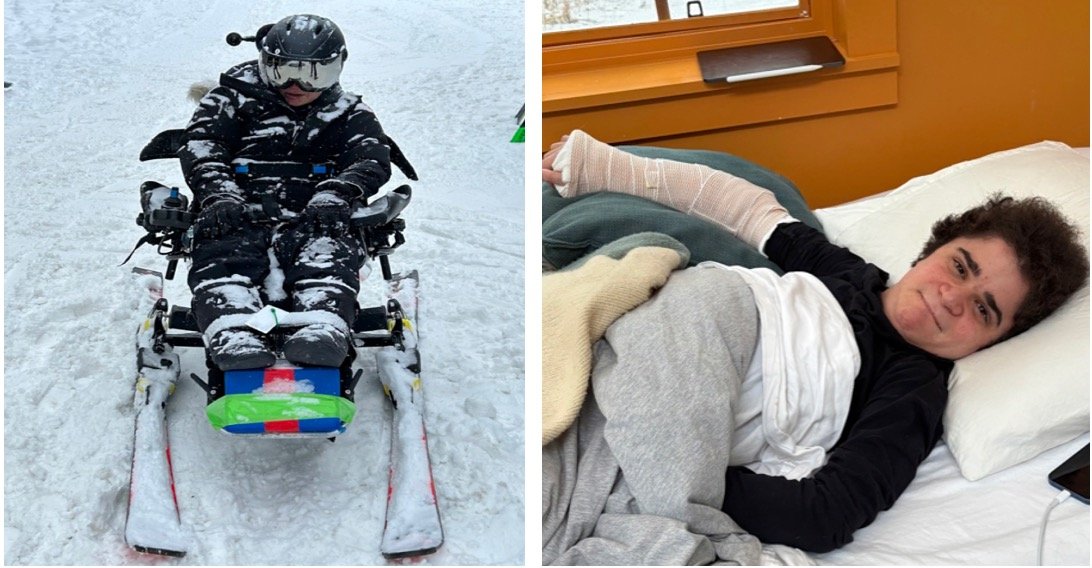Break An Arm! (New term I coined for good luck on the job market)
It was a freezing Friday when my dad and I set off for New Hampshire to hit the slopes at Cannon Mountain.
But this wasn’t just any ski trip. I was getting behind the joystick of a TetraSki, the automatic adaptive ski that only thirty exist in the world—two of them just a short drive from my hometown. Developed by a spinal cord injury rehabilitation specialist, the TetraSki made skiing accessible to people like me, and I was about to give it another shot.
A few weeks earlier, I had tested the TetraSki for the first time at Bretton Woods—the largest peak in New Hampshire and a spot right next to where The Shining was filmed. Zooming down the mountain at 20 miles an hour, I knew I’d be back for more. And this time, I was registering for a race at Cannon Mountain—not to win, but to enjoy the ride and the après-ski beers and stories that would follow.
Two coaches took me out for an afternoon ski to get three practice runs in before the race. Red and blue flags labeled Cannon Mountain were set up so we could navigate through them while coming down the mountain as fast as possible. The first run was a little rusty —nailing down the right and left turns — but we made it down safe and sound. The second run, I was nailing the turns and passing through the flags like an Olympian or X Games competitor. Except on one turn, when I came crashing into the flag and pulled it right from the ground -- but was half an inch from the perfect turn.
We had time for a third run, which we got in right before sunset while the wind was blasting and it was negative three degrees out. I came out strong, but halfway through the slope, I angled one of the skis flat during the steep portion, causing me to flip over as my right ski got stuck in the snow. I did a flip and landed on my helmet and wrist.
One of the coaches flipped me back over and I went, “Ahhh, my wrist,” but proceeded to crack up and wonder how we were going to proceed down the mountain. My right hand was now out of play to control the joystick. They helped override my control of the ski, and my instructor took me down the rest of the mountain. In the lodge, I insisted I was fine as my physician father kept poking and prodding my wrist to test if it was broken. I stubbornly bit my lip through the pain and said, “No, everything is fine.”
We went for an after-ski beer and met some nice locals we chatted with at Schilling’s Brewery near a nice fire they had going. The pain subsided a bit, but finally, my dad won out. I agreed to go to the urgent care hospital site. We checked in and waited until the technician brought in the portable X-ray machine. After two pictures, my dad quickly scanned the image before the doctor came in and went, “Oh.” It was broken, all right.
I wanted to cry. I had just agreed to take on an interesting part-time job, and I was also exploring the possibility of starting a new internship. But now, with my arm bandaged up, I couldn’t help but think about the challenge of managing it all. The pain in the moment wasn’t nearly as bad as the anxiety of what was to come. How was I going to type, let alone juggle everything, while recovering?
On the car ride home, the painkiller kicked in, and I managed to sleep, but my mind was racing. Oh boy, this month was going to be brutal.
When we finally got home in the middle of the night, I rested my arm on a pillow and, despite the chaos, we laughed. Who knew that trying something like skiing would end up in a tumble like that? Honestly, I’m not sure if I’ll get back on the slopes again — the ski sites in Utah are beautiful, but this experience made me reconsider.
Still, in a weird way, this setback has boosted my confidence. I know I’ll crush any upcoming interviews and get my full-time healthcare career underway once I’m back on my feet. And funny enough, they say “break a leg” before getting on stage in theater. Maybe breaking an arm is the momentum I need in an ironic twist.
So, Charley, Break an Arm! Good luck out there.
